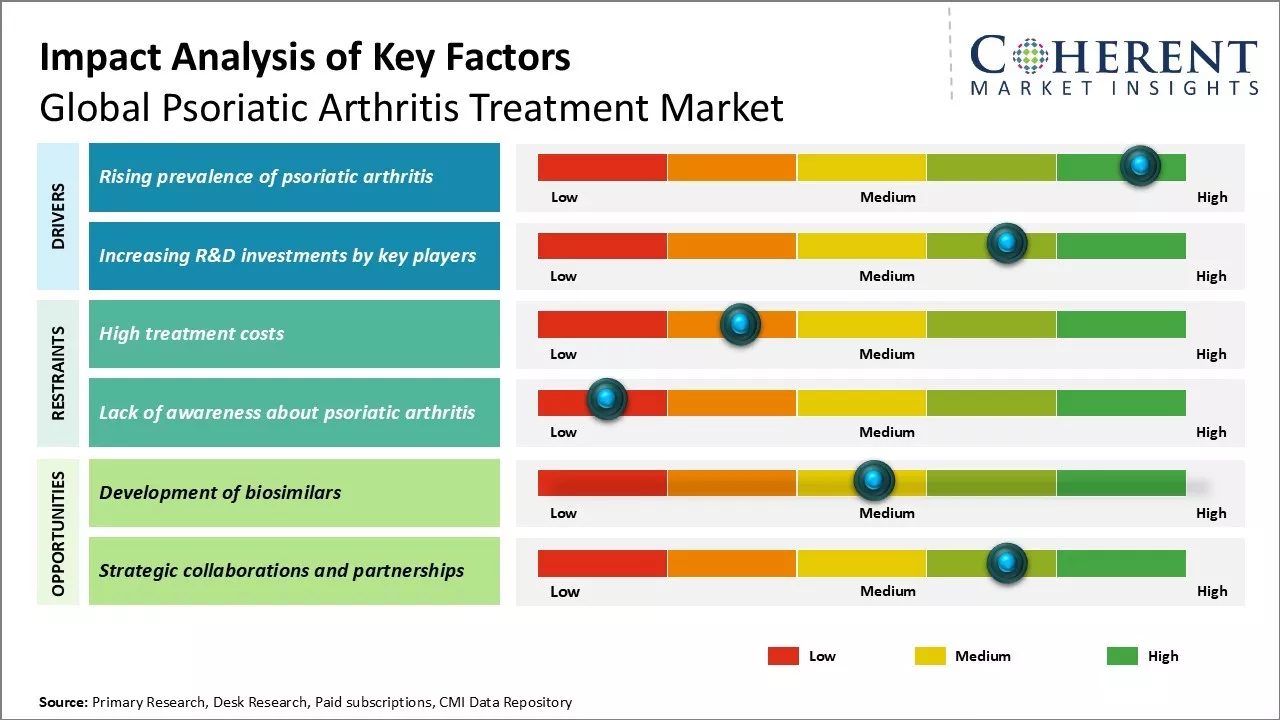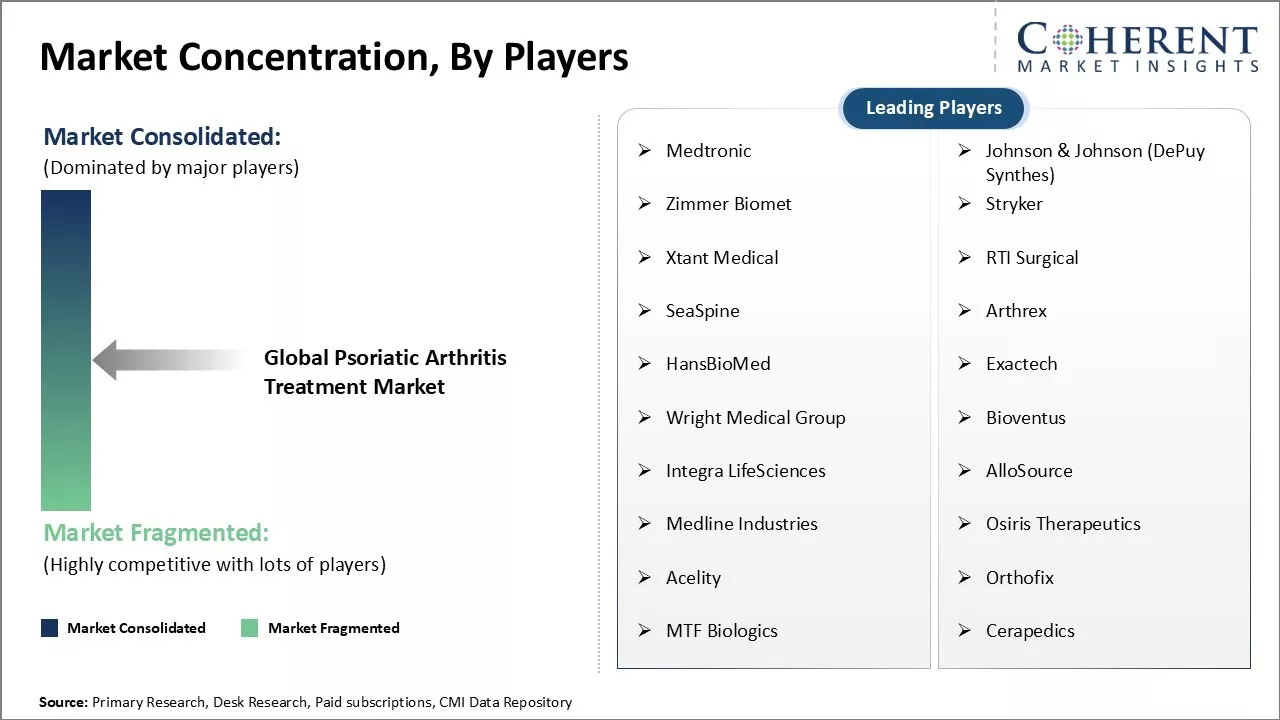Global psoriatic arthritis treatment market size is estimated at USD 12.19 Bn in 2025 and is expected to reach USD 23.47 Bn by 2032, exhibiting a compound annual growth rate (CAGR) of 9.8% from 2025 to 2032.
Global psoriatic arthritis treatment market growth is driven by rising prevalence of psoriatic arthritis across the world. Technological advancements in diagnosis and treatment of psoriatic arthritis have led to the development of newer drug classes such as interleukin inhibitors, which have improved clinical outcomes and quality of life of patients. However, high costs associated with biologic drugs for psoriatic arthritis treatment and patent expiries of blockbuster drugs can hamper the market growth.

To learn more about this report, Download Free Sample
According to the latest available estimates, nearly 30 million people worldwide suffer from psoriasis. Out of which, approximately 30% of patients suffer from psoriatic arthritis (PsA). Most physicians earlier assumed PsA to be a minor issue or a precursor to psoriasis but now clearly recognize it as a chronic inflammatory disease requiring long term treatment approach.
Population based studies show that nearly 50% of patients experience PsA onset before psoriasis, indicating delayed diagnosis is often the case. Even in developed markets, many patients have undiagnosed PsA for years, which has caused permanent joint damage by the time it was detected. Growing health impacts of PsA in terms of physical disability, impaired body functions, and mental health issues compel patients to seek treatment options.

To learn more about this report, Download Free Sample
|
Current Events |
Description and its impact |
|
Regulatory Approvals and Drug Launches
|
|
|
Clinical Trial Advancements |
|
Uncover macros and micros vetted on 75+ parameters: Get instant access to report
The psoriatic arthritis treatment market is gaining serious momentum, largely due to a rise in diagnoses and the steady introduction of targeted therapies. There's a noticeable uptick in innovation, especially with selective TYK2 inhibitors and next-gen IL-17 inhibitors making their way through clinical trials. These newer drugs are designed to offer more tailored treatment, particularly for patients who haven’t responded well to existing options.
A good example is Bristol Myers Squibb’s Sotyktu, a TYK2 inhibitor that showed strong results in a Phase 3 trial. It not only met its endpoints but outperformed existing treatments, which makes it a promising new oral option for PsA patients looking for something more effective.
A major game-changer is the rise of biosimilars. As patents expire on existing biologic drugs, many lower-cost biosimilar versions are entering the market. This creates fierce competition, pushing down prices, and making advanced therapies more accessible. The focus is shifting towards providing effective, yet affordable, and treatment options.
Global psoriatic arthritis treatment market can offer growth opportunities due to the development of biosimilar drugs. Biosimilars are essentially cheaper generic versions of original patented biologics whose patents have expired. With patents of some major blockbuster biologics like Humira, Remicade, and Enbrel expiring in the next few years, numerous pharma companies are in the race to develop high quality biosimilars for these drugs.
Increased adoption of such lower-cost biosimilars can enhance affordability and accessibility of biologic treatment regimens for psoriatic arthritis patients globally. It will also offer pharma companies an attractive revenue opportunity in the market.
In terms of drug class, the biologics segment is estimated to contribute the highest market share of 50.5% in 2025, owing to their targeted approach. Biologics such as tumor necrosis factor (TNF) inhibitors directly target specific components of the immune system associated with psoriatic arthritis, offering more effective relief of symptoms compared to traditional non-biologics.
As the pathophysiology of psoriatic arthritis becomes better understood, biologics that block cytokines like TNF, interleukin-17 (IL-17), and interleukin-23 (IL-23) have revolutionized treatment. Patients and physicians alike recognize that biologics provide superior clinical efficacy in relieving pain, swelling, and stiffness with many able to achieve disease remission.
In terms of product type, the prescription segment is estimated to contribute the highest market share of 54.5% in 2025. Unlike over-the-counter (OTC) alternatives, prescription medications for psoriatic arthritis directly target underlying disease mechanisms, offering patients more effective symptom relief.
Prescriptions can be tailored to an individual's condition severity and medical history to optimize therapy based on a provider's expertise. Prescription fill data further enables healthcare professionals to monitor patients, identify any lapses in compliance, and adjust treatment plans accordingly. Convenient characteristics like syncing prescription refills with other medications support compliance.
In terms of route of administration, the parenteral segment is estimated to contribute the highest market share of 63.5% in 2025, owing to benefits over oral delivery. Biologic drugs that suppress inflammation through targeted cytokine inhibition have revolutionized treatment but require injection or infusion administration.
Injection sites can be rotated to minimize discomfort or irritation at any one location over time. Reimbursement programs and specialty pharmacy services also help manage costs and support needs for parenteral biologics over the long-term. These collective advantages of the parenteral administration route drive its market share dominance for treating psoriatic arthritis, especially as biologics become standard first-line therapies.
| Report Coverage | Details | ||
|---|---|---|---|
| Base Year: | 2024 | Market Size in 2025: | USD 12.19 Bn |
| Historical Data for: | 2020 To 2024 | Forecast Period: | 2025 To 2032 |
| Forecast Period 2025 to 2032 CAGR: | 9.8% | 2032 Value Projection: | USD 23.47 Bn |
| Geographies covered: |
|
||
| Segments covered: |
|
||
| Companies covered: |
Medtronic, Johnson & Johnson (DePuy Synthes), Zimmer Biomet, Stryker, Xtant Medical, RTI Surgical, SeaSpine, Arthrex, HansBioMed, Exactech, Wright Medical Group, Bioventus, Integra LifeSciences, AlloSource, Medline Industries, Osiris Therapeutics, Acelity, Orthofix, MTF Biologics, Cerapedics |
||
| Growth Drivers: |
|
||
| Restraints & Challenges: |
|
||
Uncover macros and micros vetted on 75+ parameters: Get instant access to report
*Definition: Global Psoriatic Arthritis Treatment Market involves pharmaceutical and biopharmaceutical companies developing, manufacturing, and marketing drug therapies to treat psoriatic arthritis. It covers oral and injectable medications for reducing joint swelling and pain, slowing disease progression, and improving physical function in patients suffering from this chronic inflammatory arthritis condition. Major products in this market include tumor necrosis factor inhibitors, interleukin inhibitors, conventional systemic therapies, and biosimilars.
Share
Share
About Author
Ghanshyam Shrivastava - With over 20 years of experience in the management consulting and research, Ghanshyam Shrivastava serves as a Principal Consultant, bringing extensive expertise in biologics and biosimilars. His primary expertise lies in areas such as market entry and expansion strategy, competitive intelligence, and strategic transformation across diversified portfolio of various drugs used for different therapeutic category and APIs. He excels at identifying key challenges faced by clients and providing robust solutions to enhance their strategic decision-making capabilities. His comprehensive understanding of the market ensures valuable contributions to research reports and business decisions.
Ghanshyam is a sought-after speaker at industry conferences and contributes to various publications on pharma industry.
Missing comfort of reading report in your local language? Find your preferred language :
Transform your Strategy with Exclusive Trending Reports :
Frequently Asked Questions
Joining thousands of companies around the world committed to making the Excellent Business Solutions.
View All Our Clients